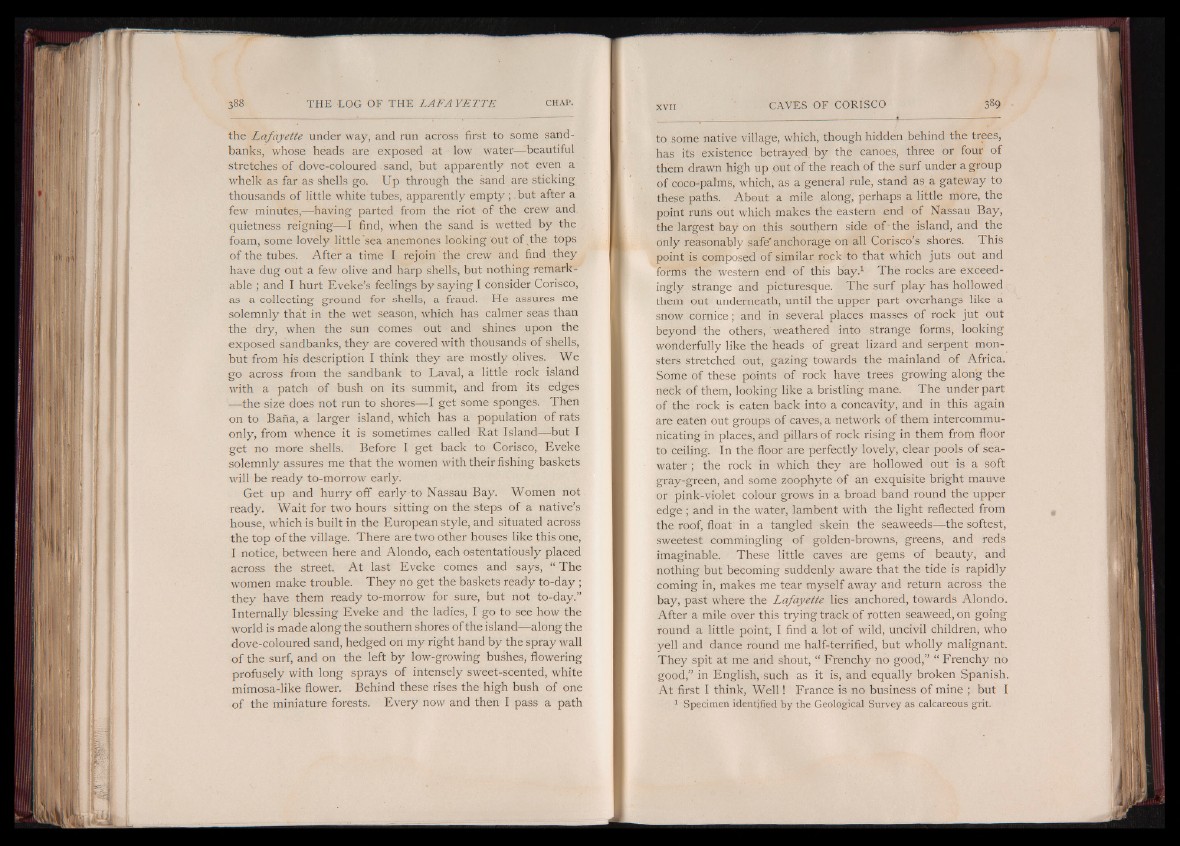
the Lafayette under way, and run across first to some sandbanks,
whose heads are exposed at low water— beautiful
stretches of doVe-coloured sand, but apparently not even a
whelk as far as shells go. Up through the sand are sticking
thousands of little white tubes, apparently empty ; but after a
few minutes,— having parted from the riot of the crew and
quietness reigning— I find, when the sand is wetted by the
foam, some lovely little sea anemones looking out of The tops
of the tubes. After a time I rejoin' the crew and find they
have dug out a few olive and harp shells, but nothing remarkable
; and I hurt Eveke’s feelings by saying I consider Coriseo,
as a collecting ground for shells, a fraud. He assures me
solemnly that in the wet season, which has calmer seas than
the dry, when the sun comes out and shines upon the
exposed sandbanks, they are covered with thousands of shells,
but from his description I think they are mostly olives. We
go across from the sandbank to Laval, a little rock island
with a patch of bush on its summit, and from its edges
— the size does not run to shores— I get some sponges. Then
on to Baña, a larger island, which has a population of rats
only, from whence it is sometimes called Rat Island— but I
get no more shells. Before I get back to Coriseo, Eveke
solemnly assures me that the women with their fishing baskets
will be ready to-morrow early.
Get up and hurry off early to Nassau Bay. Women not
ready. Wait for two hours sitting on the steps of a native’s
house, which is built in the European style, and situated across
the top of the village. There are two other houses like this one,
I notice, between here and Alondo, each ostentatiously placed
across the street. A t last Eveke comes and says, | The
women make trouble. They no get the baskets ready to-day ;
they have them ready to-morrow for sure, but not to-day.”
Internally blessing Eveke and the ladies, I go to see how the
world is made along the southern shores of the island— along the
dove-coloured sand, hedged on my right hand by the spray wall
of the surf, and on the left by low-growing bushes, flowering
profusely with long sprays of intensely sweet-scented, white
mimosa-like flower. Behind these rises the high bush of one
of the miniature forests. Every now and then I pass a path
to some native village, which, though hidden behind the trees,
has its existence betrayed, by the canoes, three or four of
them drawn high up out of the reach of the surf under a group
of coco-palms, which, as a general rule, stand as a gateway to
these paths. About a mile along, perhaps a little more, the
point rurts out which makes the eastern end of Nassau Bay,
the largest bay on this southern side of the island, and the
only reasonably safe' anchorage on all Corisco’s shores. This
point is composed of similar rock to that which juts out and
forms the western end of this bay.1 Thè rocks are exceedingly
strange and picturesque. The surf play has hollowed
them out underneath, until the upper part overhangs like a
snow cornice ; and in several places masses of rock jut out
beyond the others, weathered into strange forms, looking
wonderfully like the heads of great lizard and serpent monsters
stretched out, gazing towards the mainland of Africa.
Some of these points of rock have trees growing along the
neck of them, looking like a bristling mane. The under part
of the rock is eaten back into a concavity, and in this again
are eaten out groups of caves, a network of them intercommunicating
in places, and pillars of rock rising in them from floor
to ceiling. In the floor are perfectly lovely, clear pools of seawater
; the rock in which they are hollowed out is a soft
gray-green, and some zoophyte of an exquisite bright mauve
or pink-violet colour grows in a broad band round the upper
edge ; and in the water, lambent with the light reflected from
the roof, float in a tangled skein the seaweeds—-the softest,
sweetest commingling of golden-browns, greens, and reds
imaginable. These little caves are gems of beauty, and
nothing but becoming suddenly aware that the tide is rapidly
coming in, makes me tear myself away and return across the
bay, past where the Lafayette lies anchored, towards Alondo.
After a mile over this trying track of rotten seaweed, on going
round a little point, I find a lot of wild, uncivil children, who
yell and dance round me half-terrified, but wholly malignant.
They spit at me and shout, “ Frenchy no good,” “ Frenchy no
good,” in English, such as it is, and equally broken Spanish.
A t first I think, Well ! France is no business of mine ; but I
1 Specimen identified by the Geological Survey as calcareous grit.